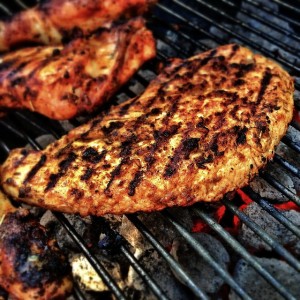A calorie deficit induces fat loss. The methods for creating a caloric deficit are debatable, however this fact is true.
For bodybuilders, aesthetic athletes, or others looking to lose fat mass for overall health reasons, this regimen of ‘creating a deficit’ via diet, exercise or both is of great interest. However, what these individuals don’t want to lose isfat-free mass; in other words anything other than fat.
The protein guidelines for weight training individuals are 1.5-1.7g/kg (1). For advanced trainers this is lower, with the muscle enhancing protein retention and the actual protein stimulus over a time period decreasing. These numbers are derived from individuals consuming enough calories to maintain weight or slightly more. Generally, most people already consume enough protein to meet this range without having to splash out on additional supplements or protein sources.
To look closer at these needs, a recent review (Helms, Zinn, Rowlands & Brown 2014) evaluated the evidence (2). Here are the main points from the review:
- The degree of calorie deficit can influence how severe a drop in fat free mass occurs, decline in anabolic hormones and decline in performance. Slower weight loss is generally much better than fast and heavily restrictive weight loss.
- Body fat influences the ‘susceptibility’ to fat free mass loss whilst on a calorie deficit. Individuals with lower levels of body fat use up to two-three fold more protein (and excrete up to twice as much) than individuals with higher levels of body fat. You could say that people with more fat mass have more ‘buffering’ to caloric deficit derived muscle loss than lean individuals.
- Leaner individuals on a caloric deficit have greater declines in free and total testosterone compared with larger individuals.
- Studies that derive protein intakes based on nitrogen balance may underestimate requirements as achieving ‘positive’ nitrogen balance doesn’t indicate what change to muscle mass has occurred. A higher ‘positive’ nitrogen balance might result in greater muscle mass retention than lower ‘positive’ nitrogen balances. In addition, nitrogen balance studies may overestimate intake versus excretion, leading to a ‘false positive’ scenario. This may explain why some studies have shown reductions in fat free mass despite holding a slightly positive nitrogen balance (3) (4).
- Analysis of weight loss studies show that a protein intake of between 2.2-3.1g/kg appears a more optimal approach particularly for leaner individuals on a greater caloric deficit.
- Lowering carbohydrate intake can compromise performance if insufficient glycogen replenishment is achieved between training bouts, therefore caloric deficits needs to ensure carbohydrate is not restricted too heavily.
- Fat intake at too low a range may impair the production of testosterone and growth hormone, and impair recovery. An intake of at least 20% of the total energy intake is likely the best course.
- Protein needs are higher in ‘newbie’ trainers and lower in experienced trainers.
To summarise, protein requirements factor in a range of factors. A person that is overweight and experienced with weight training might be better off with a lower protein intake, whilst a lean individual looking to lose fat mass might need to start increasing their protein intake.
I’ve drawn a basic graph to illustrate the idea of protein requirements:
As you can see, during weight maintenance, protein intakes for most individuals may be somewhere between 1-2g/kg. Overweight individuals may not need as much protein.
The greater the fat mass and calorie intake, the lower our need for protein. This doesn’t mean that you should gorge yourself so you don’t need as much protein, because that’s just going to increase fat mass. Overall, this equals a less than optimal body composition.
On the other hand, say we want to lose fat. I’ve tried to demonstrate that the steeper the deficit you go, the greater the protein intake. You might never know for sure the exact number, but I imagine it would look something like this.
I’ve drawn a little red part somewhere around the steepest part of the lean category. Conceivably, with a deficit you can only go so low until it is impossible to achieve enough protein intake to match requirements with the calories in hand. In addition, you wouldn’t be able to consume enough fat or carbohydrate calories, and potentially even vitamins and minerals to keep yourself going without suffering some severe muscle mass and fat losses. Not good. Basically, in other words for lean individuals and larger individuals I advise your best course (as Walter White would say) would be to ‘Tread lightly’ with calorie deficits!
Summary
Body builders tend to place a high priority on protein for bulking and weight loss, but protein appears to be most important during the weight loss phase. When looking to ‘cut’ an athlete is best advised to consume at least 2.2-3.1g/kg, with the leanest individuals likely needing an intake in the higher range. This likely equates to dietary and meal composition that emphasises a reduction in fat and excessive carbohydrate calories, to ensure that protein can be toggled upward to achieve the deficit whilst consuming enough protein.
Dot points
- Protein requirements for resistance training range from 1.2-1.7g/kg depending on the time spent training (lower needs for those who have trained longer).
- Caloric deficits increase the rate of proteolysis, and thus increase the requirements for dietary protein to maximise retention in fat free mass whilst losing fat mass. An intake of 2.2-3.1g/kg is recommended based on the review by Helms et al 2014.
- The greater the caloric deficit, the greater the requirement for protein. Small deficits may not require large protein increases.
- Individuals with lower levels of starting body fat may require higher levels of protein whilst on a caloric deficit.
References
(1) Australian Institute of Sports Nutrition 2009, Protein, viewed 6 August 2014, <http://www.ausport.gov.au/ais/nutrition/factsheets/basics/protein_-_how_much>
(2) Helms, ER, Zinn, C, Rowlands, DS, & Brown, SR 2014, ‘A systematic review of dietary protein during caloric restriction in resistance trained lean athletes: A case for higher intakes’, International Journal of Sports Nutrition and Exercise Metabolism, vol. 24, pp. 127-138
(3) Walberg, JL, Leidy, MK, Sturgill, DJ, Hinkle, DE, Ritchey, SJ, & Sebolt, DR 1988, ‘Macronutrient content of a hypoenergy diet affects nitrogen retention and muscle function in weight lifters’, International
Journal of Sports Medicine, vol. 9, no. 4, pp. 261–266
(4) Pikosky, MA, Smith, TJ, Grediagin, ANN, Castaneda-Sceppa, C, Byerley, LO, Glickman, EL, & Young, AJ 2008 ‘Increased protein maintains nitrogen balance during exercise-induced energy deficit’, Medicine and Science in Sports and Exercise, vol. 40, no. 3, pp. 505–512








0